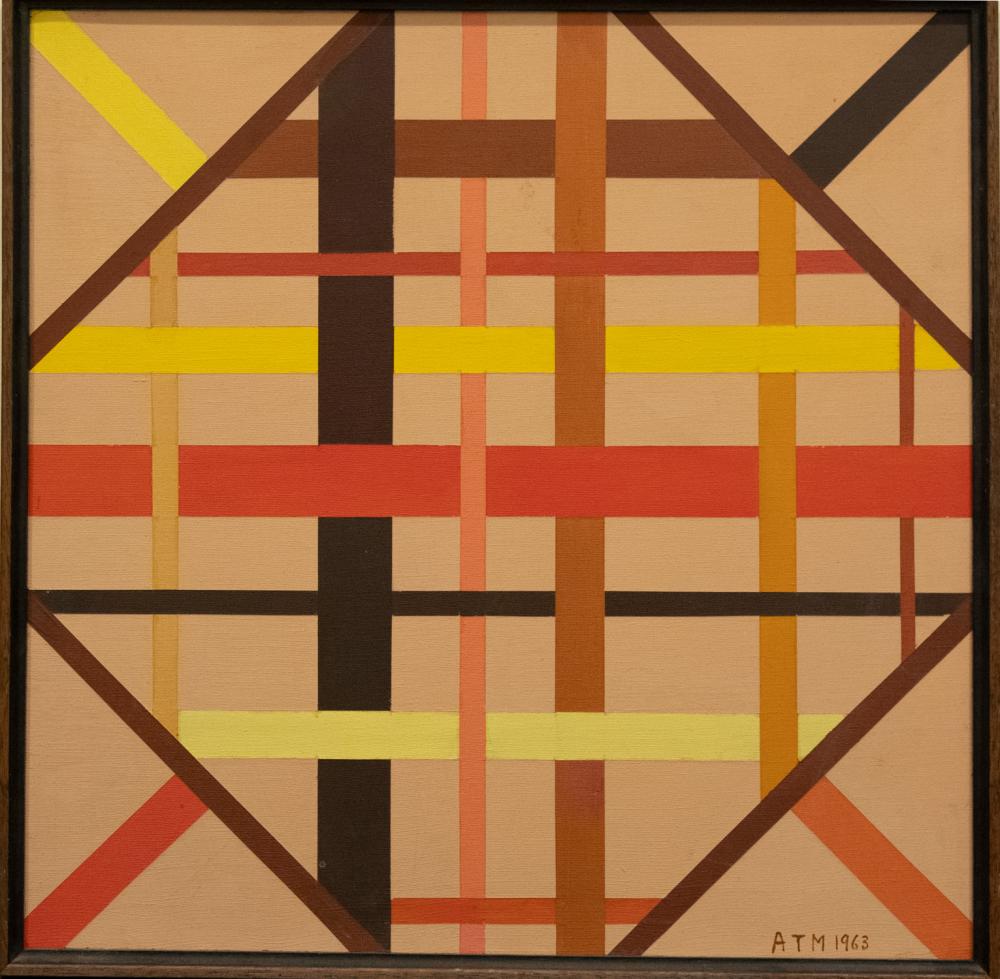(November 16, 1904 – July 16, 1971)
Alice Trumbull Mason became a staunch advocate of nonobjective art early in her career, and throughout her life she believed in its truthfulness over representational art. Born to an affluent family in Litchfield, Connecticut, Mason was a descendant of the American painter John Trumbull. Her mother had studied art in Paris in the 1880s, and her sister had studied with Fernand Léger and Hans Hofmann. In 1921 and 1922, Mason studied at the British Academy in Rome. Upon her return to New York in 1924, she entered Charles Hawthorne’s classes at the National Academy of Design. Mason’s artistic conversion came, however, as a student of Arshile Gorky at the Grand Central Art School from 1927 to 1931. Though his own work was not yet abstract, Gorky introduced Mason to the analytical aspects of Cubism and the spiritual approach of Kandinsky. During a trip to Italy and Greece in 1928, Mason was profoundly affected by Byzantine mosaics and archaic Greek sculpture. She admired the mosaics for their use of plastic elements and materials as expressive devices. She especially noted the use of line to generate motion and gilded tesserae to enhance the stylization of the line, qualities she adopted in herown untitled mosaic of 1941.(1)
In 1929, when Mason was on the brink of making abstract paintings, her mother died. Her mother’s death sparked a transition to abstraction in her work, as a “form of transferred or secularized spirituality.”(2) Abstraction for spiritual content did not become a predominant concern for Mason; instead she emphasized the potential of the medium to create meaning in her work:
“We look for nothing mystical or dream-like but the magic in the work itself. Abstract art demands an awareness of the intrinsic use of materials and a fuller employment of these means which build a new imaginative world by using them for their own potential worth.”(3)
Mason’s work from the 1930s and early 1940s shows an artist still coming to terms with a personal style. She occasionally borrowed Miró’s meandering line and Kandinsky’s amorphous color areas. She used line and color with a freedom reminiscent also of Arthur Dove’s paintings. Her works of this period, while few in number, are emotionally expressive and evocative of nature and natural phenomena. After her marriage and the birth of her two children, Mason found very little time for painting. Instead she turned to poetry for self-expression and to literature, particularly French symbolism, for intellectual stimulation. She did, however, become a founding member of the American Abstract Artists and exhibited in its first annual exhibition. An active member into the 1960s, she served as treasurer in 1939, secretary from 1940 to 1945, and in the early 1960s, was president of the group. Among her close friends in the organization were IlyaBolotowsky, whom she had known from student days at the National Academy, Ibram Lassaw, George McNeil, Esphyr Slobodkina, and Balcomb and Gertrude Greene. She also maintained close ties with Albert Gallatin, George L.K. Morris, and Charles Shaw. It was Gallatin who organized her first solo exhibition in 1942 at the Museum of Living Art.
In her article for the American AbstractArtists 1938 yearbook, entitled “Concerning Plastic Significance, Mason contended that the expressive potential of medium was the most important element within an abstract work of art. She also argued against Surrealism for its reliance on dream imagery and use of materials as “props for narrative.”(4) In her own work she explored the relationship of biomorphic forms and expressive line.
During the mid 1940s, Mason’s paintings reflected a new admiration for Mondrian’s work. She credited Mondrian, who had arrived in the United States in the fall of 1940, with inspiring her to abandon biomorphism and adopt “straight-edged” shapes.(5) Under his influence, shedeveloped theories about “displacement” and “four-way balance”, apparent in her increasing decentralization of image and use of an all-over compositional approach.(6)
In 1958, after the sudden death of her son, Mason became increasingly introspective. Her works retained a cool intellectuality but became more reductive. She turned toward an expressionist style, remaining steadfast in her rejection of representational imagery and in her belief in the primacy of plasticity.
